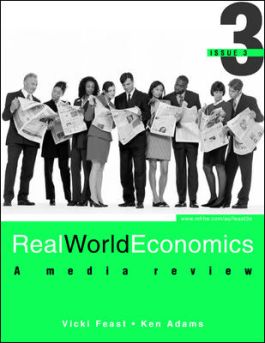Real World Economics: A Media Review
3rd Edition
0074713884
·
9780074713884
© 2003 | Published: September 30, 2003
Real World Economics links the three core elements of economics-theory, models and real-life examples-and follows the sequence of chapters most commonly used in first-year micro- and macro- economics textbooks. Interesting and relevant newspaper arti…
Read More
Receive via shipping:
- Colour, print bound version of the complete text
Preliminaries
About the authors
Introduction
Supplement 1 Media Watch Approach: Some useful economics web sites
Supplement 2 Use and integration of graphs in writing economics answers
Supplement 3 Graduate qualities
Part 1: Topics common to micro and macro economics
Chapter 1 The economic perspective
Chapter 2 Demand, supply and elasticity
Chapter 3 Business organisation
Chapter 4 International trade
Part 2: Microeconomics
Chapter 5 Consumer behaviour and choice
Chapter 6 Costs of production
Chapter 7 Perfect competition
Chapter 8 Monopoly
Chapter 9 Oligopoly
Chapter 10 Monopolistic competition
Chapter 11 Market failure
Chapter 12 Microeconomic reform and competition policy
Part 3: Macroeconomics
Chapter 13 Measuring macroeconomic activity
Chapter 14 Unemployment
Chapter 15 Inflation
Chapter 16 The Keynesian aggregate expenditure model
Chapter 17 Aggregate demand/aggregate supply
Chapter 18 Fiscal policy
Chapter 19 Money/ monetary policy
Chapter 20 Exchange rates
Chapter 21 Macroeconomic debate
Chapter 22 Poverty and inequality
End matter
Solutions in brief
About the authors
Introduction
Supplement 1 Media Watch Approach: Some useful economics web sites
Supplement 2 Use and integration of graphs in writing economics answers
Supplement 3 Graduate qualities
Part 1: Topics common to micro and macro economics
Chapter 1 The economic perspective
Chapter 2 Demand, supply and elasticity
Chapter 3 Business organisation
Chapter 4 International trade
Part 2: Microeconomics
Chapter 5 Consumer behaviour and choice
Chapter 6 Costs of production
Chapter 7 Perfect competition
Chapter 8 Monopoly
Chapter 9 Oligopoly
Chapter 10 Monopolistic competition
Chapter 11 Market failure
Chapter 12 Microeconomic reform and competition policy
Part 3: Macroeconomics
Chapter 13 Measuring macroeconomic activity
Chapter 14 Unemployment
Chapter 15 Inflation
Chapter 16 The Keynesian aggregate expenditure model
Chapter 17 Aggregate demand/aggregate supply
Chapter 18 Fiscal policy
Chapter 19 Money/ monetary policy
Chapter 20 Exchange rates
Chapter 21 Macroeconomic debate
Chapter 22 Poverty and inequality
End matter
Solutions in brief
Real World Economics links the three core elements of economics-theory, models and real-life examples-and follows the sequence of chapters most commonly used in first-year micro- and macro- economics textbooks. Interesting and relevant newspaper articles are contained in each chapter, clearly showing the connection between economic theory and real-world events. Each article is followed by an In Context section that helps students to make the connection between theory and practice. The Hints section assists students to frame an answer to the questions that are posed.
Supporting Websites
- Online Learning Center: http://www.mhhe.com/au/feast3e

